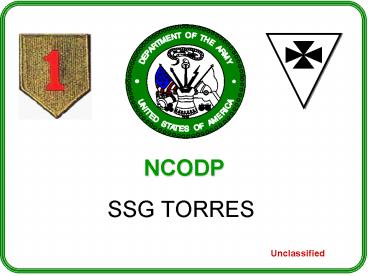NCODP - PowerPoint PPT Presentation
Title:
NCODP
Description:
Conclusion -It is up to each individual soldier to meet the standards but as leaders it is ... and body fat standards. Army ... Conduct taping after each ... – PowerPoint PPT presentation
Number of Views:154
Avg rating:3.0/5.0
Title: NCODP
1
NCODP
- SSG TORRES
Unclassified
2
Purpose
- -To inform you about the
Army Weight Control Program
-What is it
It is a program that sets forth standards and
provides incentives designed to motivate soldiers
to comply with the Army Height and Weight Table
and the body fat standards.
-Reference
AR 600-9
3
Outline
- Phase 1 IDENTIFICATION
- Phase 2 VERIFICATION
- Phase 3 INITIATION
- Phase 4 FOLLOW UP
- Summary
- Questions
- Conclusion
4
Phase 1
IDENTIFICATION
- Commanders and supervisors will monitor and
evaluate all soldiers under their command to
insure proper weight and body composition by
1. Conducting an APFT at least every 6 months.
2. Conducting a weigh-in after each APFT.
3. Conduct taping after each weigh-in for those
who did not meet the height and weight table to
see if they meet the body fat standard.
Note It is still the responsibility of each
individual soldier to meet and maintain the
standards as prescribed in AR 600-9.
5
Phase 2
EVALUATION
- Once the soldier(s) have been identified who did
not meet the height and weight table as well as
the body fat standards the commander and/or
supervisors will
1. Fill out a correspondence sheet to document
all recommendations and actions taken. This is
maintained by the commander or supervisor.
2. Send soldier(s) to get a medical evaluation
done by a health care personnel.
Note If a medical condition is found prescribe
medical treatment to alleviate condition and
return to unit or hospitalize if necessary to
receive proper medical attention.
6
Phase 2(cont.)
Example Correspondence sheet
7
Phase 3
INITIATION
- If no medical condition is found the commander
will
1. Provide soldier with a weight reduction
counseling by a health care personnel(corresponden
ce sheet)
2. Counsel the soldier to inform them that they
are being entered into the Weight Control Program.
3. Initiate DA Form 268, Suspension of Favorable
Personnel Actions(Flags).
4. Enroll soldier in a Nutrition education
session(s) conducted by qualified health care
personnel.
8
Phase 3(cont.)
Notes a. Soldiers that are flagged for being
overweight are still deployable and reassignable.
Reassignment from one unit to another, the flag
and weight control records are transferred to the
gaining unit. b. Soldiers who meet the
standards and become pregnant will be exempt from
the standards for the duration of the pregnancy
plus the period of convalescent leave after
termination of pregnancy. c.
Enrollment in a Weight Control Program starts on
the day that the soldier is counseled by the unit
commander that he/she has been entered in a
Weight Control Program.
9
Phase 4
FOLLOW UP
- Commanders and supervisors will accomplish on a
monthly basis
1. Routine weigh-ins at unit level to check
soldiers progress.
2. Percent body fat measurements in accordance
with standard methods prescribed in Appendix B of
AR 600-9.
3. Counsel soldier(s) after each weigh-in and
tape to inform the soldier of their progression
or lack there of.
10
Phase 4(cont.)
- Example of correct percent body fat measurements
for a male. All measurements are recorded on DA
Form 5500-R
11
Phase 4(cont.)
- Example of correct percent body fat measurements
for a female. All measurements are recorded on DA
Form 5501-R
12
Phase 4(cont.)
Notes a. The required weight loss goal of 3 to 8
pounds per month is considered a safely
attainable goal. b. An individual who has not
made satisfactory progress after 2 consecutive
monthly weigh-ins and tape will be referred by
the commander or supervisor to a health care
personnel for medical reevaluation. c. If no
medical condition is determined or found and the
soldier still exceeds the screening table weight
and is not in compliance with the body fat
standards the commander or supervisor will
counsel the soldier on their unsatisfactory
progress and that he/she is subject to a bar of
reenlistment and separation from the military
under the following regulations AR 635-200,
chapter 5-15, AR 635-100, chapter 5, chapter 7 or
AR 135-178.
13
Phase 4(cont.)
d. If a soldier successfully progress and meets
the height and weight table the commander will
counsel the individual on being removed from the
program and all flags lifted. e. If the unit
commander determines that the individual once
again exceeds the screening table weight and the
body fat standards within 12 months from the date
of removal from the program and no medical
condition is associated the individual will be
subject to separation from the services. f.
After the 12th month, but within 36 months from
the date of removal from the program and no
medical condition is found the individual will be
given 90 days to meet the height and weight table
or the body fat standards.
14
Phase 4(cont.)
g. Personnel who meet the body fat standard
after that period will be removed from the
program all others will be subject to separation
from the service.
15
Summary
- Phase 1 Identification Phase 2 Evaluation
- Phase 3 Initiate Phase 4 Follow
up
16
Questions?
17
Conclusion
- -It is up to each individual soldier to meet the
standards but as leaders it is up to us to
provide educational and other motivational
programs to encourage personnel to attain and
maintain proper weight and body fat standards.

